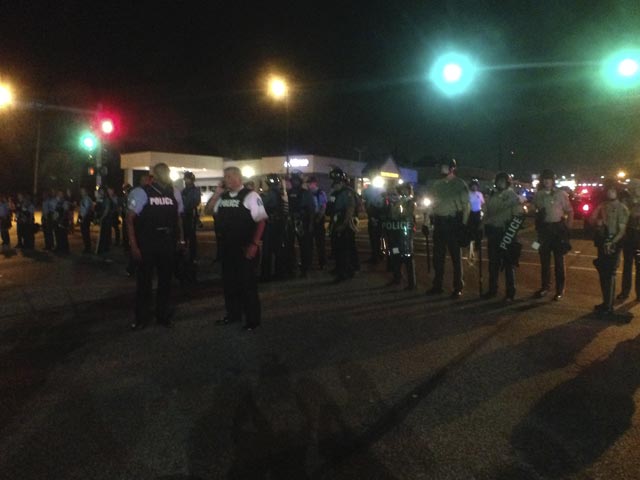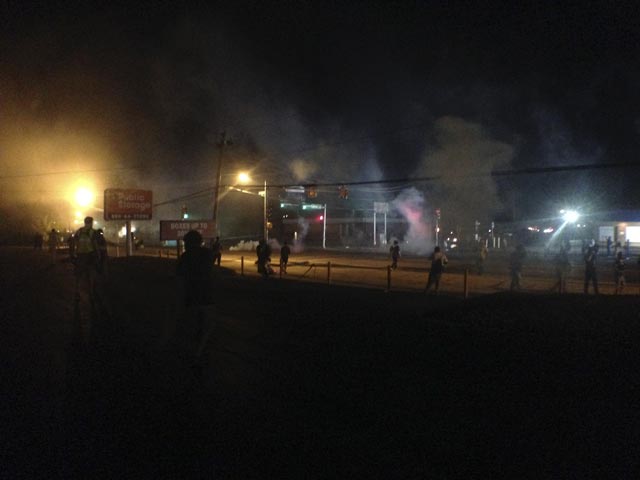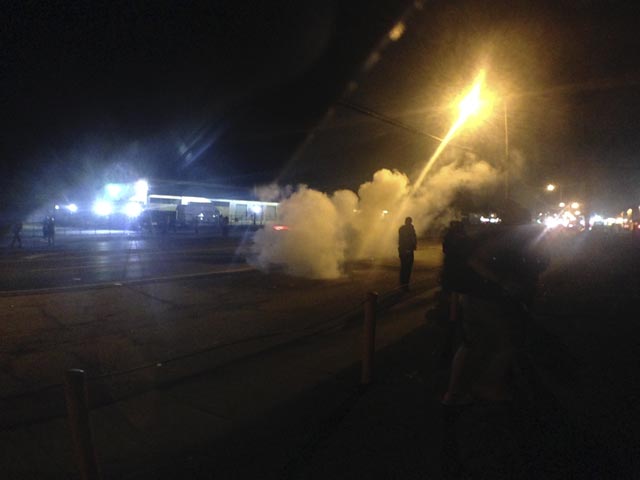
Dee Nixon said he goes out to protest in the streets of Ferguson, Missouri before work, and then comes back out again after work.
“I’m going to keep coming out, all day, everyday,” said Nixon, a 22-year-old resident of Ferguson who attended another demonstration Monday night.
Nixon said he learned from his mother that he was related to Michael Brown, the unarmed 18-year-old shot and killed by local police officer Darren Wilson on August 9, only after Brown died. His daily participation in the protests against the killing, Nixon said, is “all about family.”
“Because it could have happened to any of us,” Nixon told me.
As we spoke, a scuffle broke out across the street as a group of riot police grabbed and arrested a protester. Hundreds of people had just finished marching in protest of Brown’s killing and the general treatment of black people in the St. Louis area by law enforcement.
 A row of riot cops and National Guardsman stood with weapons drawn and armored vehicles and squad cars parked behind. (Photo: Mike Ludwig)
A row of riot cops and National Guardsman stood with weapons drawn and armored vehicles and squad cars parked behind. (Photo: Mike Ludwig)
Many of the marchers had already gone home, but dozens of activists, journalists, community leaders and youth – visibly angry about the murder of their peer – had stayed at an intersection, where a row of riot cops and National Guardsman stood with weapons drawn. Behind them was a line of armored vehicles and squad cars leading back toward a command center established in a strip mall by state police.
Local businesses on the street had boarded up their windows after several nights of clashes on West Florissant Avenue, where the city’s most confrontational protests have occurred over the past week.
People in Ferguson have been protesting for 10 days now and are showing no sign of stopping. Police have blamed “criminals” and outside agitators for stirring up violence during nighttime demonstrations, but on Monday night, it was clear that the police – along with their military-grade weapons – were a provocation in and of themselves. It was a cop that fatally shot Michael Brown, after all.
“We’re just trying to have the same rights as you,” one angry demonstrator told a group of mostly white journalists.
“I think it’s the fact that everybody is upset. This has happened too many times,” said a local man who told me his name was Gerard. “First I thought they were going to continue with [the protests] until they released the officer’s name, you know, but now I think they are going to keep going until the officer is convicted.”
A few skirmishes broke out in the intersection where police had drawn their line in front of the command center and constructed a media pen for journalists in a parking lot, but after a few arrests were made, the crowd thinned and it seemed like the protest was over. Then, down the street, the familiar sounds of flash bang grenades were heard as sparks and tear gas filled the air.
 (Photo: Mike Ludwig)
(Photo: Mike Ludwig)
 (Photo: Mike Ludwig)
(Photo: Mike Ludwig)
Protesters had dragged traffic cones and portable toilets into the street, and a few small fires could be seen burning through the tear gas. Gunshots rang out from a side street. Some protesters grabbed the gas grenades and threw them back.
As the smoke cleared and activists treated people blinded by tear gas, police could be seen casing a restaurant with automatic weapons drawn. Protesters told reporters that the police starting filling the street with tear gas after a few plastic bottles were thrown.
“My anger is seeing my people, black or white, brown or blue, getting hurt,” said Travis Sowell, a 19-year-old black man who gave an emotional testimony to reporters after the clash. “What I’m going to do is stand here every night . . . no pillow, no covers.”
A group of young protesters, unfazed by the clash and the tear gas, soon began chanting “Mike Brown” in front of the news cameras.
In an early morning press conference, Missouri Highway Patrol Capt. Ron Johnson, who has taken over security in Ferguson, blamed “criminals” and outside agitators for inciting the violence that sparked aggressive police responses in Ferguson, and asked that the community no longer protest at night.
Gerard’s friend Mike, who had a T-shirt wrapped around his face, told me that violence broke out during a protest on the night of August 17 only after the police tried to contain demonstrators.
“Everybody from Ferguson is from around here, this is their neighborhood,” Gerard said. “Even outside people, it hits home. St. Louis is not a big city; we’re a big little city . . . if this guy doesn’t get convicted, man, for shooting an unarmed 18-year-old, then it’s going to be chaos.”
Police had cleared the streets by 2 am, but the late-night protesters in Ferguson had once again made their point. If there is no justice for Michael Brown, there will be no peace.
Join us in defending the truth before it’s too late
The future of independent journalism is uncertain, and the consequences of losing it are too grave to ignore. To ensure Truthout remains safe, strong, and free, we need to raise $31,000 in the next 48 hours. Every dollar raised goes directly toward the costs of producing news you can trust.
Please give what you can — because by supporting us with a tax-deductible donation, you’re not just preserving a source of news, you’re helping to safeguard what’s left of our democracy.